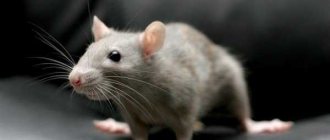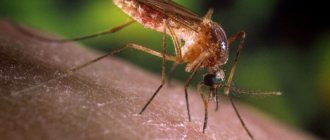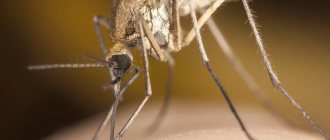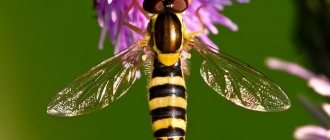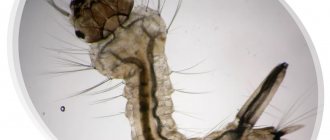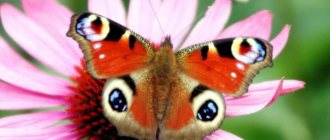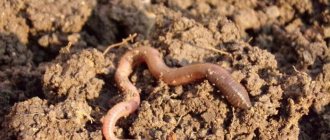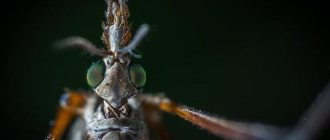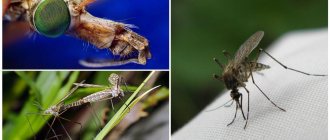Mosquitoes are often the name given to all vile creatures that feed on human blood: mosquitoes, midges, horse flies. But this is not true.
To understand what a mosquito is and how it differs from its fellow subfamily of long-whiskered insects, the mosquito, you need to know what it looks like, its habitat and the consequences of bites for humans.
Description and appearance
The appearance of mosquitoes is not impressive, since their small size (1.5–2 mm) and pale color do not look threatening.
The insect's body has short hairs that even appear along the edges of the wings, giving it a slightly fluffy appearance. On the head there are clearly visible antennae and black eyes that resemble small beads. The long proboscis is used for obtaining food.
Appearance
The elongated oval wings, even at rest, remain raised above the body at a certain angle. Mosquitoes fly at speeds of up to 3–4 m/sec, but prefer to move in peculiar jumps.
Only females are predators of these insects, while males feed on plant sap.
Types of mosquitoes and their habitats
Mosquitoes belong to the subfamily of long-whiskered dipterous insects included in the midge complex. About seven hundred species form several genera, the most numerous of which are:
- Phlebotomus;
- Sergentomyia;
- Lutzomyia.
For a comfortable existence and reproduction, mosquitoes need a warm climate, where there are rarely negative temperatures. Therefore, the main habitat is the tropics and subtropics. In Russia, they inhabit the southern regions: Krasnodar region, Crimea, Stavropol region.
In recent years, due to climate warming, mosquitoes have begun to be found in more northern latitudes, where they had never been recorded before.
Story
Mosquitoes are relatively ancient insects; their probable origin dates back to the Lower Cretaceous period. The first description of a male of unknown genus was published in Rome by Filippo Bonanni in 1691. Type species, Phlebotomus papatasi
, was described by Scopoli in 1786, but the connection between mosquitoes and human diseases was known earlier: back in 1764, the Spanish doctor Cosme Bueno published a book about popular beliefs about the transmission of leishmaniasis and bartonellosis in the Peruvian Andes, where he indicated that the local population connects the occurrence of these diseases with the bites of small insects called “uta”.
Peculiarities of mosquito behavior
The main feature of mosquitoes is the time they search for victims. Female insects begin to be active during sunset for 1.5–2 hours. Attacking in a whole swarm, they stick around the victim, getting into the nose and ears. Areas not protected by clothing suffer the most.
A person or animal is attacked only by females. They need blood to reproduce.
Before biting, the mosquito makes several jumps on the skin and only then pierces the epidermis, releasing a blood thinning substance into the wound. Its saturation process is short, so it can fly away before life is threatened.
Differences from mosquitoes
Mosquitoes and mosquitoes belong to the same subfamily of long-whiskered insects. But the differences are so significant that it is difficult to confuse them.
Differences in appearance
You can distinguish between an adult mosquito and a mosquito:
- in size - the mosquito is noticeably smaller;
- by the location of the wings at rest: in the first they are at an angle, in the second they are parallel to the body;
- by the color of the abdomen: the mosquito will have a predominantly white tint, the mosquito will have a brown or greenish tint;
- along the hairs on a mosquito's body.
Clear differences can be seen during insect flight. Mosquitoes fly chaotically and make a characteristic squeak. Mosquitoes can develop high speeds, prefer to move in jerks, and are silent.
Habitat for mosquitoes and mosquitoes
The main difference between a mosquito and a mosquito is the latter's intolerance to low temperatures. Therefore, it is forced to live and reproduce in countries with warm climates. The mosquito is distributed almost everywhere, except in places constantly covered with ice and snow. This is due to its ability to hibernate during unfavorable weather conditions.
Larvae
Both of them look for places with high humidity, near fresh water bodies.
Reproduction nuances
Mosquitoes, like mosquitoes, go through a full transformation cycle, consisting of 4 stages: egg, larva, pupa, adult. The difference is that mosquitoes lay their eggs in water, while mosquitoes prefer moist soil, like tree roots. The larvae of the former feed on aquatic microorganisms and plants, while the latter feed on organic waste.
The egg stage of a mosquito lasts up to 7 days. The time depends on the type of insect, the ambient temperature and the rate of blood digestion. The sharp “egg tooth” on the head of the larva helps it get out of the egg, since its shell is quite strong. During the first moult it is shed.
The newly hatched larva resembles a white caterpillar with a dark head. A total of four moults occur before becoming a pupa. During this phase, the pupa is already somewhat similar in shape to the adult.
Like mosquitoes, mosquitoes are bisexual. For the appearance of offspring, not only fertilization of the egg is required, but also the blood of the victim, without which the maturation of the embryo freezes. The law of gonotrophic harmony is triggered.
Due to the fact that the process of laying eggs is quite difficult, the female mosquito most often dies after this, leaving up to 60 eggs. The surviving females drink blood again and lay eggs again. The third clutch consists of individual unique cases.
Reproduction
9 days after the blood-sucking session, the female lays 30-60 eggs. The entire life cycle, from egg to adult mosquito, takes about 7 weeks. The larva that emerges from the egg a week later molts 4 times. In total, the growth process to the pupal stage takes an average of 1 month. After the 4th stage, the larva pupates and after 11 days an adult insect emerges from the egg.
But if we take into account not just the active phase of life of bloodsuckers, but their adaptability to unfavorable climatic conditions, then the question of how long mosquitoes live becomes no longer so clear-cut. If the timing of development were strictly observed, mosquitoes would become extinct within one year. They have lived since the Cretaceous period and are not going to disappear.
The secret here is diapause, characteristic of many Palaearctic species. Adults freeze out in winter, regardless of when they reach the adult stage - 2 months or 2 days before frost. The larvae of the fourth stage of development, capable of falling into suspended animation, “go away” for the winter.
The appearance of adult insects in large numbers at once in summer is also explained by diapause. The larvae emerging from the suspended state at the end of May - beginning of June pupate almost simultaneously. The emergence of adults from pupae also occurs at the same time.
What diseases do mosquitoes carry?
Mosquito bites are dangerous, like the same malaria mosquitoes, since they are also carriers of bacteria and viruses that cause various diseases in humans:
- Leishmaniasis. It is caused by protozoan parasites and is transmitted to humans through the bite of a mosquito from certain species of rodents and canines. The disease is most common in Africa and South America. Manifests itself in the form of ulcerative papules. May cause damage to internal organs. There is a high risk of death in young children.
- Bartonellosis. Caused by Bartonella bacteria. First, a papule appears at the site of the wound. The bacteria will then spread through the bloodstream. Causes fever, headaches and muscle pain. In the chronic stage, a papular rash appears on the face, neck and limbs, developing into specific nodules. If left untreated, the patient may die.
- Pappataci fever. An influenza-like illness caused by arboviruses transmitted by a mosquito bite. It is expressed by a sudden increase in temperature, severe headache. The treatment outcome is favorable.
When to see a doctor
In most cases, mosquito bites are tolerated relatively well, provided that adequate treatment is provided in a timely manner. After a few days, inflammation and discomfort disappear without specialized treatment. There are several following conditions in which a visit to a doctor is indicated:
- A large number of bites caused by insects over a relatively short period of time.
- Children under 3 years of age.
- Localization of bites in the face and neck, which increases the risk of toxic compounds, mediators of allergic and inflammatory reactions directly into the brain tissue.
- The appearance of the first signs of the development of severe systemic allergic reactions.
- Development of signs of human infection with diseases whose pathogens are carried by mosquitoes (headache, severe intoxication, enlargement of regional lymph nodes, their soreness).
Consequences of mosquito bites
In addition to the risk of getting a dangerous disease, mosquito bites are unpleasant in themselves. They are very painful and take a long time to heal. A red swelling forms at the site of the wound and severe itching appears. Complications may occur:
- Scratching can introduce pathogenic bacteria into the wound.
- An enzyme injected during a mosquito bite that prevents blood clotting can cause severe allergies.
- If a person is highly sensitive to mosquito bites, phlebotoderma may develop. This is a skin lesion where itchy nodules appear all over the body.
Bites
To prevent this from happening, you need to take measures:
- Wash the bite area under running water and soap or wipe with a swab dipped in a solution of baking soda.
- Apply ice to the wound to relieve itching.
- Use medications that relieve swelling and eliminate itching.
- For allergies, use antihistamines.
If the measures taken do not help, you should consult a doctor.
Help
After a mosquito bite, it is important to immediately carry out the following simple first aid measures:
- Rinse the bite area with plenty of running water, preferably with soap.
- Treatment with an antiseptic solution; hydrogen peroxide is best suited for this.
- Reducing the severity of the inflammatory reaction by applying local cold (you can use a piece of ice, cold water, which is pre-wetted with a napkin).
- Use of medications for local external use - after a mosquito bite, you can use anti-inflammatory and antihistamine ointments or creams (Lokoid, Sinaflan).
- The prescription of antihistamines (Loratadine, Suprastin) for systemic use is justified when signs of allergic reactions appear.
You can also reduce the severity of the inflammatory reaction using improvised means. After applying cold, the bite area is treated with propolis tincture, boric alcohol, onion slice, baking soda solution, calendula tincture or toothpaste (not necessarily gel). If intoxication develops, it is important to lie down for several hours. At the same time, during the day it is advisable to increase the amount of fluid entering the body (tea, fruit juice, dried fruit compote).
Sources
- https://FB.ru/article/355570/moskityi—eto-krovososuschie-nasekomyie-opisanie-i-mesta-rasprostraneniya-moskitov
- https://heaclub.ru/moskit-i-komar-otlichiya-kak-otlichit-moskita-ot-komara-po-vneshnemu-vidu-srede-obitaniya-osobennostyam-razmnozheniya
- https://stopklopu.com/otlicia-komarov-ot-moskitov/
- https://apest.ru/komary/o-komarah/otlichiya-komarov-i-moskitov/
- https://td-te.ru/vrediteli/chem-otlichayutsya-komary-ot-maskitov.html
- https://apest.ru/komary/o-komarah/moskity/
- https://100zaitsev.ru/chlenistonogie/moskity-eto-2.html
- https://Dezoff.ru/komary/moskity/
- https://rci76.ru/klopy/moskity-i-komary.html
- https://ot-allergii.ru/ukus-moskita.html
[collapse]
Ways to combat mosquitoes
People living in cold climates are at risk of mosquito bites only when traveling to southern countries. Therefore, before traveling, you must undergo the recommended vaccination. This will help avoid sad consequences.
You can protect yourself from attacks by bloodsuckers using ointments and gels that repel insects. In addition, it is not advisable to be on the street during a mass flight of mosquitoes in search of victims. Clothes should cover the body as much as possible and be loose. Particularly dangerous are places near bodies of water with standing water. Spending time around them is risky.
Mosquito nets or gauze will help protect the room. You can use ultrasonic repellers or chemicals.
Protection
On air
Residents of central Russia and residents of regions of the country with a more severe climate may be at risk of encountering mosquitoes only during tourist trips to “hot countries.” To protect yourself on vacation, you need to get the recommended vaccination for visiting a particular area, and also remember the basic means of protection against mosquitoes and mosquitoes:
- Wear loose clothing that covers your body as much as possible: loose shirts, baggy pants.
- Try not to overheat or sweat; To do this, choose clothes in light colors, and also reduce the time you spend outdoors.
- Try not to leave the premises during morning and evening twilight, the preferred time for insects.
- When outdoors, try to stay away from wetlands, standing water or swamps, especially in cold weather.
- Using special gels, ointments and aerosols before going out into the fresh air. You have to treat all exposed areas of the body.
In the house
To secure your home, you need to use:
- rare fabric or tulle.
- gauze;
- mosquito net;
How to get rid of mosquitoes in the house if they have already gotten there? Simpler aerosol preparations, such as the well-known Dichlorvos, will help.
If you have a swimming pool at home or nearby, do not let the water in it stagnate and “bloom.” This will attract dangerous insects to the area, and therefore it will be very difficult to get rid of mosquitoes.
Attention! Any place with standing water is a potential breeding ground for mosquitoes, and you and your pets will provide the blood needed for the parasite to reproduce!
In addition to all sorts of chemical or ultrasonic methods that are so popular at the moment, remember that the best mosquito killer is the person himself. You can simply deal with the problem if:
- slam it between your palms;
- hit with a newspaper or a special cracker;
- catch an insect;
When you catch and kill mosquitoes by hand, do not let them bite you, otherwise the whole hunt may become useless.
Advice! It is necessary to destroy all mosquitoes in the room until the last minute, then take measures to protect the room from re-invasion.
The harm and benefits of mosquitoes
Complete destruction of mosquitoes in a certain area can cause irreparable harm to the ecosystem of that area. These insects are an important part of the food chain. They feed on many species of birds, reptiles and other animals. The larvae perform their function by processing organic waste, which increases soil fertility.
A mosquito bite is dangerous for people. Serious diseases carried by these insects or severe allergies can sometimes be fatal.
